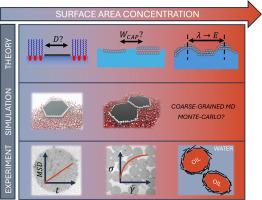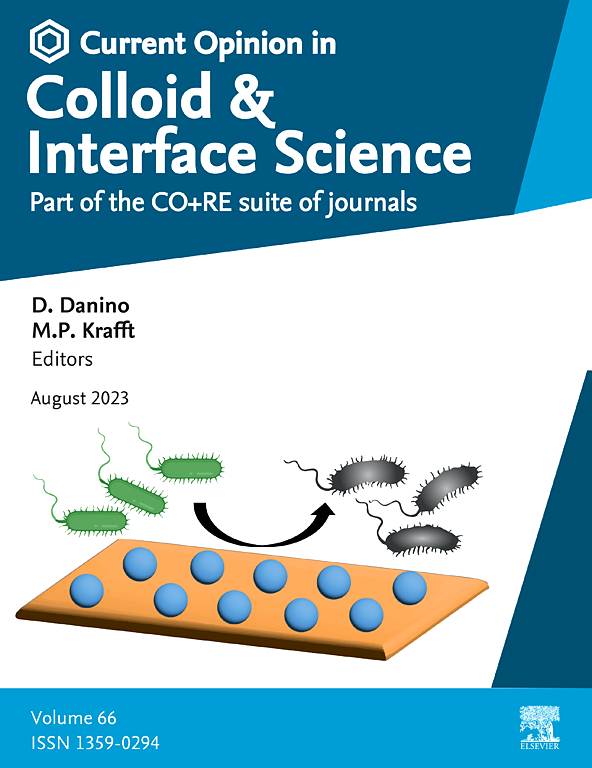Dynamics and rheology of 2D particles at fluid–fluid interfaces
IF 7
2区 化学
Q1 CHEMISTRY, PHYSICAL
Current Opinion in Colloid & Interface Science
Pub Date : 2024-09-05
DOI:10.1016/j.cocis.2024.101857
引用次数: 0
Abstract
Two-dimensional (2D) particles can be confined to a fluid–fluid interface to create a rheologically-complex interface with dynamic particle–particle and particle–membrane interactions that are still poorly understood. There are dozens of bulk materials from which 2D particles can be made, including graphene, graphene oxide, hexagonal boron nitride, molybdenum disulfide, and MXenes, and there is interest in utilizing them because of the unique properties they have over their bulk counterparts. Increasing use of 2D materials in consumer products and novel materials science applications such as Pickering emulsions, composite foams, and films, adds urgency to improve our understanding of how the atomically thin nature and variable chemistry of 2D particles makes their dynamics and interfacial rheological properties at fluid–fluid interfaces different than spheroidal particles. This short review highlights key advances that have been made in understanding the dynamics of 2D particles at fluid–fluid interfaces, including in interfacial rheology and particle–particle dynamics, and it includes discussion on important future research directions.

流体-流体界面上二维颗粒的动力学和流变学
二维(2D)粒子可被限制在流体-流体界面上,从而形成流变学上复杂的界面,其粒子-粒子和粒子-膜之间的动态相互作用至今仍鲜为人知。二维颗粒可由数十种块状材料制成,包括石墨烯、氧化石墨烯、六方氮化硼、二硫化钼和二氧化二烯类,由于它们比块状材料具有独特的性能,因此人们对利用它们很感兴趣。二维材料在消费品和新型材料科学应用(如皮克林乳液、复合泡沫和薄膜)中的使用日益增多,这使我们更迫切地需要了解二维颗粒的原子薄性和可变化学性质如何使它们在流体-流体界面上的动力学和界面流变特性与球形颗粒不同。这篇简短的综述重点介绍了在理解二维粒子在流体-流体界面上的动力学(包括界面流变学和粒子-粒子动力学)方面取得的主要进展,并讨论了未来的重要研究方向。
本文章由计算机程序翻译,如有差异,请以英文原文为准。
求助全文
约1分钟内获得全文
求助全文
来源期刊
CiteScore
16.50
自引率
1.10%
发文量
74
审稿时长
11.3 weeks
期刊介绍:
Current Opinion in Colloid and Interface Science (COCIS) is an international journal that focuses on the molecular and nanoscopic aspects of colloidal systems and interfaces in various scientific and technological fields. These include materials science, biologically-relevant systems, energy and environmental technologies, and industrial applications.
Unlike primary journals, COCIS primarily serves as a guide for researchers, helping them navigate through the vast landscape of recently published literature. It critically analyzes the state of the art, identifies bottlenecks and unsolved issues, and proposes future developments.
Moreover, COCIS emphasizes certain areas and papers that are considered particularly interesting and significant by the Editors and Section Editors. Its goal is to provide valuable insights and updates to the research community in these specialized areas.

 求助内容:
求助内容: 应助结果提醒方式:
应助结果提醒方式:


